Abstract
The idea of the application for the preclinical diagnosis of breathing disorders during sleeping, on the basis of acoustic signal recording, is presented in the hereby paper. Research on the algorithm allowing to draw conclusions concerning breathing disorders was preceded by the experiment, of recording acoustic signals of the representative group of patients during their pharmacological sleep. Combining sound signals properties with knowledge of the experienced medical practitioner, supported by the results of the advanced medical diagnosis, should made possible the development of the tool for assessing breathing disorders (especially sleep apneas) on the basis of sound signals of patients having breathing disorders. This paper is focused on problems related to the main activities leading to the development of the efficient algorithm of assessing patient’s condition: experimental recording and methods of acoustic signals analysis. Further research stages will contain the implementation of the obtained results for the needs of the mobile application development.
1. Introduction
Breathing disorders cause sleep disturbances and contribute to a deterioration of the human organism functioning during the daily activity and in the case of young children can even causes cognitive and behavioral problems [1]. Usually this type of disturbances are accompanied with acoustic effects, popularly known as snoring, which are triggered by vibrations of soft tissues within the oropharynx [2]. According to the questionnaire tests (OBOP 2016, ordered by CM MML) snoring concerns approximately 13 million of Polish citizens, mainly men.
Breathing disorders during sleep are uncomfortable for snoring persons and for people around. Breaks in breathing longer than 10 seconds and repeating themselves 10 or more times in one hour of sleep (eventually 30 and more times in 6 hours) are symptoms of the illness called Sleep Apnea Syndrome (SAS). Increasing awareness of hazards as well as inconveniences related to snoring incline to undertake attempts of laryngological treatments, including operations, improving the airflow through upper airways. However, a lot of people reporting inconveniences related to snoring have too small recommendations for surgery. This situation at the current medical practice can be found only after expensive clinical examinations, often performed during the pharmacological sleep. Thus, there is an urgent need of looking for alternative, cheap diagnostic methods allowing to eliminate easily patients not having medical indications for further clinical examinations. Sound effects accompanying breathing problems indicate, in the most natural way, the acoustic signal as the potential information source [3-6]. Also, experiences gathered during solving problems of vibroacoustic diagnostics of technical objects [7-9] constitute reasons for the preliminary selection of people, having snoring inconveniences, on the basis of acoustic signals properties.
2. Idea of the diagnostic tool
Growing interest of diagnostics of breathing disorders causing snoring constitutes an inspiration for the development of a simple, not complicated tool, available for a wide range of users. Such tool should allow to perform the preliminary test, regardless of a visit to a local clinic, and provide an information concerning either needs of further diagnostics or a lack of recommendations for treating by surgery methods.
Snoring is an acoustic phenomenon caused by vibrations of soft tissues within the oropharynx [10] and in consequence its assessing by acoustic techniques should be possible. Methods based on the analysis of the signal frequency structure are widely applied in several fields, amount others in technique and medicine. They were also used in speech signals processing [11-14]. Thus, high sensitivity of the acoustic signal for breathing disorders during the sleeping phase as well as usefulness of frequency analysis methods for assessing the patient’s condition, should be expected.
The idea of the diagnostic tool assumes a possibility of the acoustic signal monitoring during sleeping, together with isolating sounds essential for assessing breathing disorders. On the basis of the preliminary verification of isolated signal fragments, the user should be able to obtain by himself the information whether his complaint requires further diagnostics and treatments or that it does not constitute a direct health hazard. An eventual further total clinical diagnostic will be preceded by an attempt of determining the snoring causes on the acoustic signal basis, after the interactive communication of the patient and doctor via a website of the clinic specializing in treating breathing disorders.
The presented idea of the tool for the acoustic diagnostics of breathing disorders is based on individual mobile sound recording devices, equipped with the application for the preliminary verification of symptoms, and cooperating with the server supporting further conclusions. Signals recorded by an individual sound recorder at home, during sleeping after being sent to the server and verified by the doctor, can serve as the information source for the preliminary diagnosis of the snoring causes. At the current general availability, the function of the recorder communicated with the server can be well fulfilled e.g. by the mobile phone with the Android system. Technical details will be established during further research.
Creating algorithms of the concluding process of the snoring causes (eventually only of the need of a further diagnostics) is possible provided that the qualifying criteria, based on properties of acoustic signals recorded during sleeping (certain “snoring measures”), are formulated. Considerable chances of succeeding are related to technical diagnostics techniques using descriptors defined in time and frequency domains [9].
3. Experimental tests
Development of the diagnostic tool, according to the presented concept, requires obtaining representative snoring samples related to the patient’s breathing airways. To this aim the experiment for building the data base of signals representative for various illness states, was planned and performed. More than 100 people were tested. Acoustic recording was carried out in the operating theatre by means of the measuring microphone, hanging directly above the sleeping patient (during his pharmacological sleep, Fig. 1).
Fig. 1Operating theatre with the measuring microphone and the sound recording set
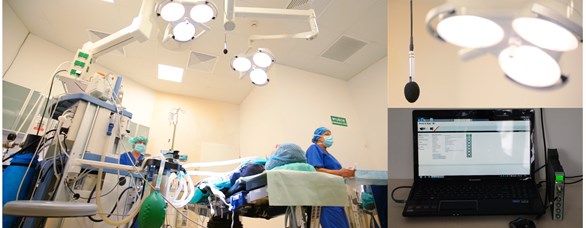
Signals were recorded by the PULSE multi-analyser of the Bruel&Kjaer Company (Fig. 1), which was also used for signals processing. Every patient was subjected to the detailed clinical diagnosis, including computer tomography of upper breathing airways, acoustic rhinometry, or fibro endoscopy [15]. In this way the explicit connection of patients having specific complaints with the recorded signals was achieved.
4. Results examples
The preliminary analysis of the recorded material inspired undertaking efforts to use the Fourier Transform for assessing breathing disorders. In consideration of the character of the tested acoustic signals (non-stationary) limiting considerations to the frequency domain solely, does not allow to obtain satisfactory and explicit results, due to a low time resolution. It especially concerns the preliminary stage of acoustic signals selection and frequency bands carrying diagnostic information on the patient’s health disorders. It was necessary to extend concluding to three domains: time, frequency and amplitude. The spectra being the bases for drawing conclusions were obtained by the Fourier transform of fragments of time waveforms observed when the specific acoustic phenomenon occurred (Fig. 2).
Fig. 2Instantaneous spectrum of the separated acoustic phenomenon
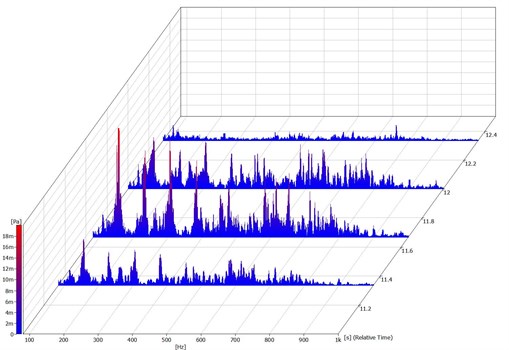
Observations of the frequency structure changes of acoustic time waveforms, allow to recognize fully the properties of the separated phenomenon. Assessments of the disorder duration time, growing intensity, frequency of occurring and instantaneous structure changes caused by the loss of breath – which was significantly hindered when the analysis was limited to the frequency domain become possible. Utilizing such method of analysis allows to build the whole matrix of diagnostic discriminants of the individual acoustic effect in each time point of its duration. A combination of the wide data base of results with medical knowledge creates real conditions for building not complicated application allowing for the preclinical diagnosis of breathing disorders within quite broad range of illness symptoms.
The analysis was performed for the selected waveforms of acoustic signals of patients having breathing disorders during the sleep phase [9]. Recording of signals in the operating theatre forced the elimination of disturbances related to the operations of medical devices monitoring patients. These disturbances, in spite of a relatively low sensitivity to noises, could made difficult the concluding correctness. Thus, before beginning the proper analysis the objectionable components (from the point of view of concluding on signal structure changes) had to be removed. The accurate comparison of the acoustic pressure changes and time-frequency spectra allowed to select fragments of time waveforms representing acoustic pressure changes causes by illness disorders. The example in presented in Fig. 3.
Fig. 3Examples of the spectrum with marked characteristic areas
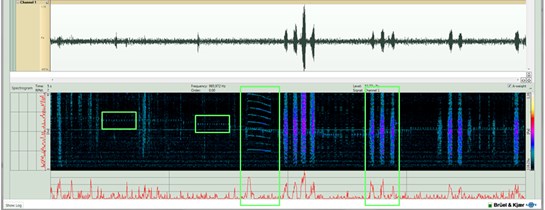
Areas characteristic for the specific time fragments of the recorded acoustic signal are marked in the spectrum. Two first marked areas are related to the operation of the heart monitoring equipment. Properties representing operations of the blood pressure monitoring device are seen in the third area. It is only when we look at the fourth marked area we can see spectrum changes characteristic for snoring. Defining characteristic properties of specific acoustic effects allows to separate fragments which are not essential for the breathing disorders diagnostics and thereby to analyse only the signal elements which are representative for the illness disorder.
The suitability of the presented procedure in assessing a patient’s condition known due to the previous complete clinical diagnosis is shown in three examples. These results are illustrated in Figs. 4, 5 and 7, containing diagrams of the selected fragments of acoustic pressure changes in time as well as instantaneous spectra representing the illness disorders.
In the case of patient A, the character of pressure changes, similar to the changes caused by snoring was observed within the whole recorded time range. Two fragments of the highest amplitude level were selected for the detailed analysis. Spectra for two-time steps (the highest signal energy) indicate significant similarities of the frequency structure. Instantaneous spectra of successive time steps of the separated individual acoustic phenomenon are significantly similar to each other in the frequency range with relatively smooth changes of increasing and decreasing of amplitudes. This phenomenon is observable within a relatively wide frequency range. Subjective feelings of the person listening to the recorded signals confirm also significant similarities. Patient A was diagnosed as having a chronic sinusitis as well as some (not numerous) incorrect changes in the nasal cavity structure which cause the breathing obstruction.
Fig. 4Patient A: a) time waveform of the recorded acoustic pressure, b) instantaneous spectra of the analysed acoustic pressure waveforms
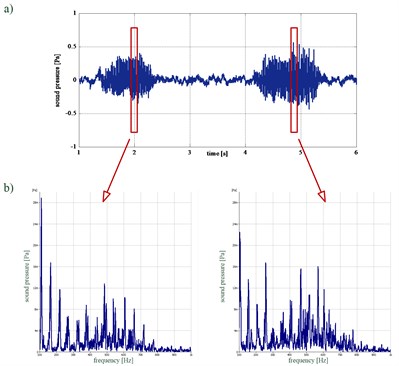
The fragment of the time waveform of the acoustic pressure of patient B and two selected instantaneous spectra are shown in Fig. 5.
Fig. 5Patient B: a) time waveform of the recorded acoustic pressure, b) instantaneous spectra of the analysed waveforms of the acoustic pressure
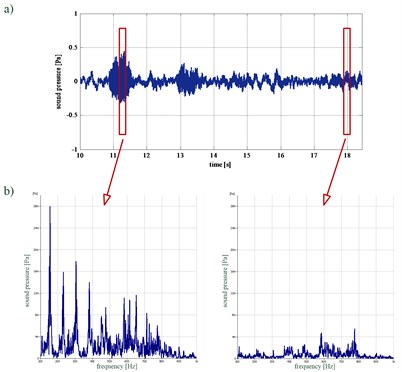
The first of the presented instantaneous spectra indicates similarity, in frequency measures as well as in amplitudes, to the instantaneous spectra from the acoustic pressure waveforms recorded for the first patient. However, already the second spectrum presented in Fig. 5 differs significantly in its structure from the observed until now changes in the spectrum image caused by acoustic phenomena occurring during the recording procedure. The second spectrum was obtained from the acoustic pressure waveform range in which breathing disorders and difficulties with their normalization were clearly heard. An occurrence of such phenomenon caused a significant change of the spectrum image. The signal energy, within a range to app. 300 Hz, lowered significantly (the image was similar to instantaneous spectra of the signal not containing acoustic phenomena). An acoustic energy increase was observed only in a range of higher frequencies (above 300 Hz). In the case of this patient a lack of a smooth decrease of the acoustic pressure level in the final phase of snoring, was also observed. Probably it results from the fact, that the majority of snores were finished either by an instantaneous stop of breathing or by disturbances in the airflow through the upper breathing airways.
Conclusions drawn from the observations of spectra (changes of frequency structures) find certain reflections in the medical diagnosis. One of the methods of assessing breathing disorders during sleeping is computer 3D tomography (allowing to assess the tissue morphology). The results of such examination performed for the analysed patient B are presented in Fig. 6. As the result of the consultation and examinations numerous abnormalities in the structure of the nasal and mouth cavities as well as of the throat which in effect provide the sleep apnea were diagnosed in this patient.
Examples of the analytical results of the last patient, considered at this stage of investigations, are presented in Fig. 7.
Acoustic phenomena occurring during the acoustic signal recording for the third analysed patient (patient C) are significantly different than the ones occurring when the other two patients were tested. In this case there are also differences in the signals frequency structure. In the case of the second spectrum it is possible to separate certain components occurring at the phenomenon called snoring, however the frequency changes range is limited, and the acoustic impressions are different than the ones analysed in previous cases. The first spectrum was determined for the moment in which the breathing disorder occurred. In this case we are also dealing with a different acoustic impression. This patient was diagnosed with the upper airways resistance syndrome (UARS).
The observed repeatable frequency structures in case of the snoring phenomenon occurrence, regardless of the patient, as well as differences resulting from various acoustic effects of breathing disorders allow to state, that the detailed analysis of instantaneous spectra images will enable the accurate and explicit identification of breathing disorders during the sleeping phase.
Fig. 6Computer 3D tomography of the upper breathing airways performed for the analysed patient B
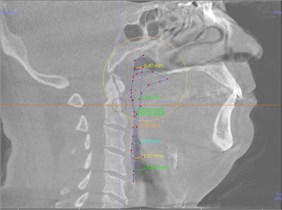
Fig. 7Patient C: a) time waveform of the recorded acoustic pressure, b) instantaneous spectra of the analysed waveforms of the acoustic pressure
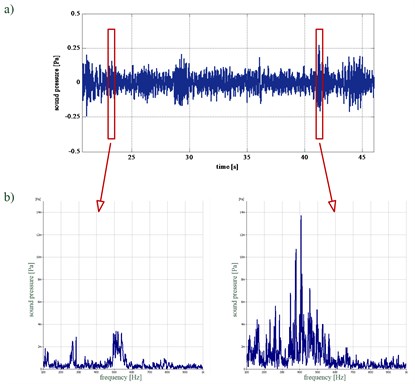
5. Conclusions
Results of the performed examinations clearly justify appropriateness of the innovatory idea of the tool for the preclinical assessment of breathing disorders during sleeping, based on acoustic descriptors. The combination of experiences of doctors and engineers creates conditions for widening and improving medical diagnoses with methods based on information contained in the sound signals, which up to now were utilized to a very small degree only. The developed tool should enable the patient to obtain by himself information whether his symptoms require deepened diagnosis or that these symptoms do not threat his health and life directly.
There are also real indications to formulate at the present research stage the hypothesis that the deepened analyses will allow to conclude, on the basis of acoustic signals, the snoring causes. In consequence, the developed method can constitute the bases for the advanced tool supporting ear, nose and throat specialists in diagnosing breathing disorders during sleeping and even in selecting the adequate, most efficient treatment method.
References
-
Smith D. L., Gozal D., Hunter S. J., Kheirandish Gozal L. Frequency of snoring, rather than apneae-hypopnea index, predicts both cognitive and behavioral problems in young children. Sleep Medicine, Vol. 34, 2017, p. 170-178.
-
Michalik M., Wiśniewski M. Sleep apnea. Medical Tribune Stomatologia, 2009.
-
Levartovsky A., Eliran Dafna E., Zigel Y., Tarasiuk A. Breathing and snoring sound characteristics during sleep in adults. Journal of Clinical Sleep Medicine, Vol. 12, Issue 3, 2016, p. 375-384.
-
Akhter S., Abeyratne U. R., Swarnkar V. Characterization of REM/NREM sleep using breath sounds in OSA. Biomedical Signal Processing and Control, Vol. 25, 2016, p. 130-142.
-
Janott C., Schuller B., Heiser C. Acoustic information from snoring sounds. HNO, Vol. 2, 2017, p. 107-116.
-
Pevernagie D., Aarts R. M., De Meyer M. The acoustics of snoring. Sleep Medicine Reviews, Vol. 14, Issue 2, 2010, p. 131-144.
-
Klekot G. Influency of non-linear elements as a symptom of changes in technical objects conditions. Diagnostyka, Vol. 48, Issue 4, 2008, p. 57-60.
-
Deuszkiewicz P., Dziurdź J., Pakowski R., et al. Vibroacoustic diagnostics of vessel’s turbine engines. ITE PIB, Radom, 2009.
-
Klekot G. The use of measures of propagation of vibroacoustic energy for condition monitoring and as a tool for noise management. ITE PIB, Warszawa, Radom, 2012.
-
Michalik M., Wiśniewski M. Treatment of obstructive sleep apnea syndrome. Medical Tribune Stomatologia, 2009.
-
Potepa L., Szaleniec J., Wszołek W., et al. Analysis of voice modifications for persons after tonsillectomy. Acta Physica Polonica A, Vol. 125, Issue 4, 2014, p. 49-56.
-
Wszołek W., Izworski A., Izworski G. Signal processing and analysis of pathological speech using artificial intelligence and learning systems methods. Acta Physica Polonica A, Vol. 123, Issue 6, 2013, p. 995-1000.
-
Ziółko B., Ziółko M. Speech Processing. Wydawnictwa AGH, 2011.
-
Wszołek W., Kłaczyński M. Comparative study of the selected methods of laryngeal tone determination. Archives of Acoustics, Vol. 31, Issue 4, 2006, p. 219-226.
-
Klekot G., Michalik M. An analysis of a possibility to use vibroacoustic methods for the diagnosis of the sleep apnea syndrome. 6th International Congress of Technical Diagnostics, 5th International Conference on Condition Monitoring of Machinery in Non-Stationary Operations, 2016, Gliwice.
